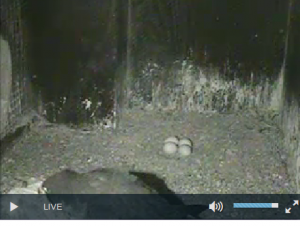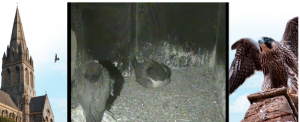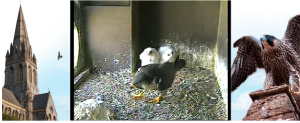For new update 29 May, scroll to bottom.
The breeding season for our resident Peregrine Falcon pair nesting high in the Spire of St Michael’s, Mount Dinham, has begun.
A couple of days later than in recent years, the first egg was observed by Nick Dixon to be laid at 7.07am on the morning of Maundy Thursday, 24th March. The birds occasionally sit on their first egg, but incubation proper does not start until their third egg has been laid.
The laying of the second egg on Holy Saturday, 26th March, was some time between 2.30pm and 5pm, about 58 hours after the first, but if you can help us fix the time more exactly, please let us know by email contact or twitter reply.
We would hope that a third egg will be laid in the wee small hours of Tuesday 29th March.
Update 1. Thanks to Nick Dixon for seeing the 3rd egg laid this morning at 7.27am (BST), 63 hours or so after the 2nd egg. Incubation proper should now be starting, ‘shared’ by both adults. Based on previous years for our Peregrine pair, we would hope for chicks to be hatching after about 32-34 days, so 29th April – 1st May as a best guess.
Will they lay a 4th egg this year, on Thursday afternoon? And if so when will we spot it under the sitting adult?
Update 2. Yes, pretty sure I’ve just glimpsed a 4th egg, which must have been laid between 6.45pm and 7.30pm BST Thursday 31st March. Incubating adults now hunker down over their eggs like a slate-blue Thunderbird 2. Female does most of the sitting, but calls loudly to the male when needing a comfort/food break.
Yes, definitely 4 eggs.

This is the 20th consecutive season of egg-laying at St Michael’s Mount Dinham; the first 11 using an external E-facing shelf, the last 9 in the nest box mounted inside the SW-facing trefoil opening high in the Spire some 20-odd years ago.
Probably the “third generation” of breeding adults, with present male since 2005 and present female since 2009.
There are pros & cons to Peregrines using such an enclosed nest site – are there any similar ones elsewhere? Adults, eggs and chicks all have more protection from spring gales and summer storms during the breeding season, and from predators. There are risks from accumulation of debris (we have virtually no chance to clean it) – only 2 out of 4 eggs hatched last year and one of the chicks in 2015 was weak on fledging. But overall their record is good.
Update 3. Tue 12 April and both adults are attentive to the task of incubating their 4 eggs; just over a third of the way through. A screenshot from a couple of nights ago showing both in the nest box.
Update 4. May 4th Wednesday and we have 2 little peregrine chicks and 2 eggs still being incubated. For those who’ve not been following events on our @StMikes_Exeter twitter feed, the first hatching seems to have occurred around 4.50am on Mon 2nd May, 34 days after 3rd egg was laid; thanks to Wendy Bartter for notification and a
After quite a long wait a second chick hatched around midnight into Wed 4th May, notified by Ingrid Bwouwer, and today both adults were actively bringing prey into the nest box to feed these two, while still sitting the 2 remaining eggs and keeping the young eyases warm.
Update 5. May 12th Thursday. Unfortunately the other 2 eggs will definitely not hatch now, and the adults are gradually losing interest in incubating them as they concentrate on feeding the 2 young chicks. Indeed, the eyases are growing and developing apace, sitting up against each other, feeding well and really starting to flex their little wings, with the first hints of independent movement too. Here’s a screenshot from the evening of the 6th with both adults and the small chicks. Note the vertical markings of the juvenile in the pinnacle photo compared to the horizontal markings you will see on the adults.

Update 6. Sun 29th May. Hopefully you’ve seen from Twitter or Facebook that Nick & Jason were able to measure and ring the 2 chicks last Monday, 23rd. Growth and development seems fine and it appears we have 2 male chicks this year. The unhatched eggs were removed under licence for analysis. Since then the chicks have started to look more advanced, with feathers coming to replace their down, starting to part feed themselves, bouncing around the nestbox (sometimes out of view of the camera) and noticing the world outside. Best guess for fledging is around 12th June, Music Sunday at St Mike’s and the weekend of official celebrations for the Queen’s 90th birthday.

